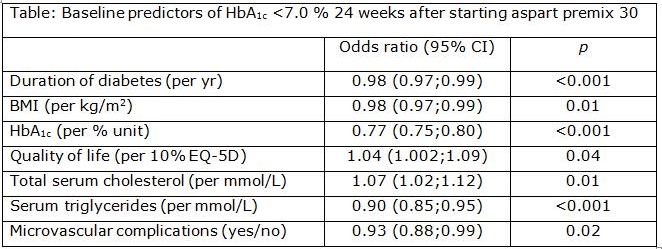Oral Presentation The Annual Scientific Meeting of the Australian Diabetes Society and the Australian Diabetes Educators Association 2013
Predictors of good blood glucose control in people receiving biphasic insulin aspart 30 premix insulin: data from the A1chieve study (#80)
Objectives: Premix insulins are widely used to enable the effective management of both basal and prandial glucose. Target HbA1c levels have been shown to be achievable in up to 66% of people with type 2 diabetes (T2DM). This subgroup analysis of the A1chieve study investigated which factors predicted the achievement of an HbA1c level of <7.0 % in a large population starting aspart premix 30.
Methods: A1chieve was an international, prospective, multi-center, non-interventional, 24-week study evaluating the safety and clinical effectiveness of insulin analogs in 66,726 people with T2DM. In this subanalysis, data from people receiving aspart premix 30 were examined to elucidate baseline characteristics which were statistically correlated with attainment of good blood glucose control, defined as HbA1c <7.0 %, at week 24. All statistical analyses were two sided, using a pre-specified 5% significance level, unless otherwise stated.
Results: Data from 29,834 participants begun on aspart premix 30 were analyzed. Of these, 9387 people (31.5%) achieved HbA1c levels <7.0 % by week 24. In this group HbA1c fell from 9.0 (SD 1.8) to 6.4 (0.4) % (mean change –2.6 [1.8] %) compared with a fall of -1.8 (1.6) % from 9.7 (1.6) % in the whole premix aspart group. Multivariate analysis indicated that, after adjustment for regional differences, the factors identified as predictors of an HbA1c of <7.0 % were: shorter duration of diabetes, lower baseline BMI, HbA1c and triglycerides, and a lower prevalence of microvascular complications (Table). Age, FPG, postprandial glucose and systolic blood pressure at baseline did not emerge as independent predictors.
Conclusions: Several factors did independently predict achievement of target HbA1c levels in people with T2DM starting aspart premix 30. These seem to be markers of lesser overall metabolic disturbance and shorter duration of diabetes.

Acknowledgment: Novo Nordisk